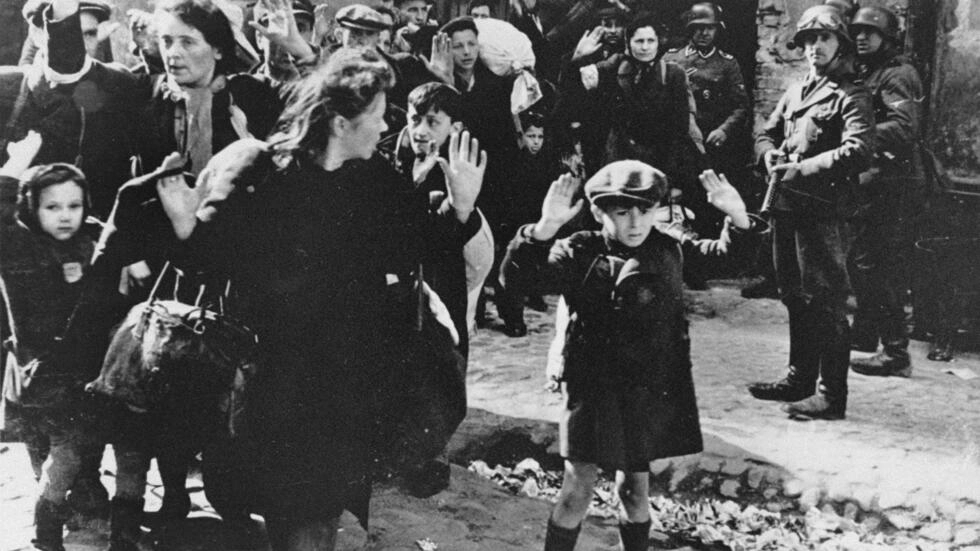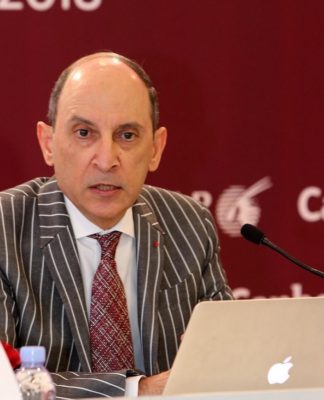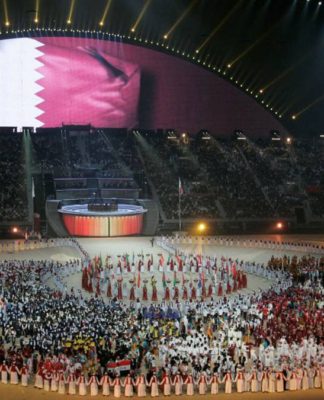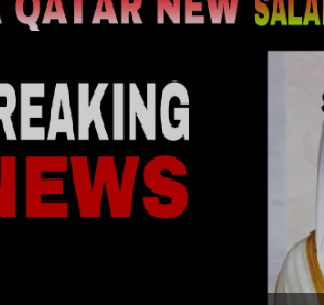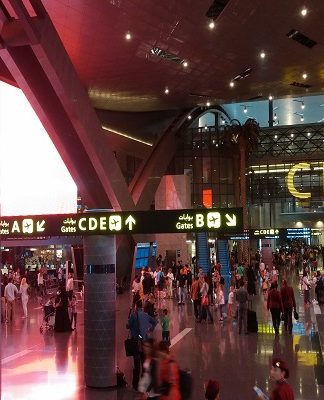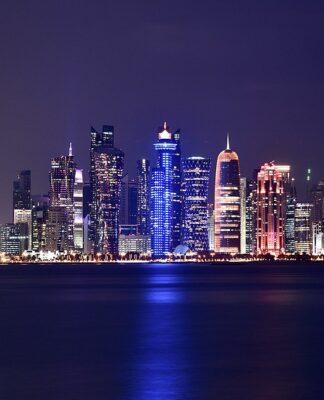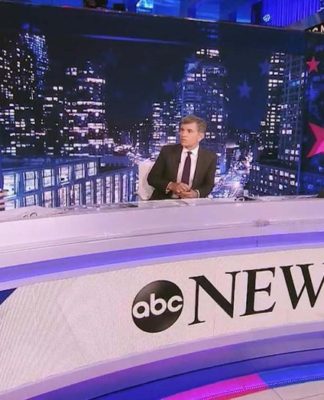WORLD WAR II
The Warsaw Ghetto Uprising: An act of desperate resistance by Polish Jews
Issued on: 18/04/2023 – 06:42
In this April 19, 1943 file photo, a group of Jews are escorted from the Warsaw ghetto by German soldiers.
In this April 19, 1943 file photo, a group of Jews are escorted from the Warsaw ghetto by German soldiers. AP
Text by:
David GORMEZANO
8 min
It is one of the most emblematic events of World War II. On April 19, 1943 a handful of Jewish fighters revolted against Nazi barbarism that had methodically undertaken the deportation and extermination of 400,000 Jews crowded into the Warsaw ghetto since July 1942. Three weeks after the final uprising, nothing remained of the ghetto and its inhabitants. Only 40 survivors managed to escape through the city sewers.
“We do not wish to save our lives. None of us will come out of this alive. We want to save the honour of mankind.” These words attributed to Arie Wilner, one of the fighters of the Warsaw Ghetto Uprising, summarise the choice of 500 fighters of the Jewish Combat Organization (JCO): dying through armed resistance against the German army rather than disappearing in the death camps interspersed across Nazi-occupied Poland.
The act, as heroic as it was desperate, marked the end of the Warsaw ghetto. On May 16, 1943 only smoking ruins remained after three weeks of fighting. The revolt had been reduced to nothing; the remaining survivors were deported to extermination camps. Only forty survivors managed to escape Warsaw through the sewers to join the Polish resistance, far from the capital.
Adapted for cinema by Roman Polanski in “The Pianist”, the event was the culmination of the initiative to annihilate the Jews of Poland during the Second World War. “The creation of ghettos and the separation from the Aryans established by the Nazis in 1940 was almost a return to the Middle Ages. Before the Second World War, 10 percent of the Polish population, or about 3 million people, were Jewish,” said Audrey Kichelewski, specialist on the history of Poland and co-director of the Revue d’histoire de la Shoah (Shoah History Review).
File picture taken in the 40’s of a tramway going around a street of the Warsaw Jewish ghetto, displaying a Star of David.
File picture taken in the 40’s of a tramway going around a street of the Warsaw Jewish ghetto, displaying a Star of David. © AFP
The destruction of the Jews of Poland
For the Jewish population of Poland, the Nazi occupation was a long and inexorable descent into hell. “The Warsaw ghetto was sealed on November 16, 1940 and surrounded by a three-metre-high wall with barbed wire. It extended over an area of about three km2, which was less than three percent of the city’s area at the time. About 400,000 Jews, including ones who lived in Warsaw before the war as well as those from towns surrounding the capital who were brought there by force, were locked up in the ghetto. The density was frightening,” said the historian.
The Germans established a “Judenrat” (“Jewish council”) who were in charge of implementing Nazi orders and organising forced labour. With the spread of hunger and disease, the population of the ghetto rapidly declined (100,000 people perished between November 1940 and July 1942). The chief administrator of the Warsaw district and Nazi officer, Ludwig Fischer, stated during a meeting on April 3, 1941 that, “hunger and misery will lead to the disappearance of the Jews. Of the Jewish question, only a cemetery will remain”.
A man carries away the bodies of dead Jews in 1943 in the Warsaw ghetto, where people began to die of hunger in the streets.
A man carries away the bodies of dead Jews in 1943 in the Warsaw ghetto, where people began to die of hunger in the streets. © AFP, Archive
The Germans took a further step in the summer of 1942 when they organised huge raids in the ghetto and deported 6,000 to 7,000 people every day to Treblinka, 100 km northeast of Warsaw. First established as a work camp, Treblinka became a death camp in July 1942. “For the Jewish youth movements [Communists, Zionists and Bundists], there was no longer any possible doubt, this was systematic killing. They decided to turn to resistance,” said the historian.
To die with guns in their hands
With only 60,000 inhabitants left in the ghetto, the Jewish Combat Organization was born on July 28, 1942. It had around 500 fighters under the leadership of Mordechai Anielewicz, a 23-year-old Polish Zionist activist and socialist. Another movement, the Jewish Military Union, a right-wing Zionist movement, consisted of 250 members. Members from both groups joined forces with the Polish resistance outside the ghetto to communicate and obtain weapons.
“On January 18, 1943 there was a first uprising. The Germans entered the ghetto to carry out a new roundup and were surprised with gunfire. The operation was a symbolic success: the deportations were interrupted, which encouraged the fighters to continue the resistance in hope that the Allies would quickly arrive,” said Kichelewski. Between January and April, resistance fighters built bunkers and created an underground city. The Polish resistance (communist and non-communist) on the other side of the ghetto wall sold and supplied arms to the insurgents in small quantities.
On April 19, 1943 the day of Passover, hundreds of German soldiers entered the ghetto. “The Jewish resistance immediately gave the signal to hide and resist, surprising the Germans and forcing them to retreat. To face the urban guerrilla warfare, 2,000 policemen and SS men returned equipped with tanks, artillery and flamethrowers, and began to liquidate the ghetto by setting the buildings on fire one by one in order to force the Jews out of the bunkers. They used poisonous gas. The fighting was unbalanced because on the opposite side, there were only revolvers and grenades,” said the historian.
A Jewish man is arrested by German soldiers in April 1943 after the uprising of the Warsaw ghetto during World War II.
A Jewish man is arrested by German soldiers in April 1943 after the uprising of the Warsaw ghetto during World War II. AFP, Archive
On May 8, Mordechai Anielewicz committed suicide. By May 16, the last bunkers were destroyed and the remaining survivors were either buried alive or arrested. “Some insurgents, including Marek Edelman, another insurgency commander in his twenties, managed to escape the ghetto in extremis through the sewers and emerge on the other side of the city. It is through them that the story of the insurrection has come to us.”
80 years of commemorations
According to Kichelewski, the news of the event spread immediately after the insurgency and had its effects. “The story of the uprising filtered through Poland very quickly. The information circulated and the action was imitated in many ghettos and camps in occupied Poland, for example, in Sobibor or in Auschwitz.”
Commemorations for the Warsaw Ghetto Uprising began as soon as the war ended. On April 19, 1948 the fifth anniversary of the start of the Warsaw Ghetto Uprising, a monument to the heroes of the ghetto financed by Jewish organisations was unveiled. “The Communist government promoted the memory of the brotherhood in arms of Jews and Poles in the anti-fascist struggle. Highlighting the uprising also allowed the government to avoid addressing the memory of Warsaw in August 1944, when the Red Army waited for the non-communist Polish resistance to be massacred by the Nazis before invading the part of Poland still occupied by the Germans,” said Kichelewski.
In Israel, in a kibbutz located north of Akka, Holocaust survivors founded the Ghetto Fighters’ House in 1949. “For the young Jewish state, it was very important to celebrate the heroism of the Jews and go against the idea of weak and passive Jews who might have allowed themselves to be led to the slaughterhouse,” said the historian.
In this December 7, 1970 file photo, West German Chancellor Willy Brandt kneels down during his visit in the former Jewish ghetto of Warsaw, Poland, where the European war started when Germany invaded on September 1, 1939.
In this December 7, 1970 file photo, West German Chancellor Willy Brandt kneels down during his visit in the former Jewish ghetto of Warsaw, Poland, where the European war started when Germany invaded on September 1, 1939. AP, Archive
In Poland, the commemoration of the Warsaw Ghetto Uprising regularly becomes a political and memorial battle. “In Communist Poland, the Ghetto Uprising was commemorated but without the Jews. The few remaining Jewish survivors gave conventional speeches,” said Kichelewski. In the 1980s, Marek Edelman, one of the five commanders of the ghetto insurgency (who died in 2009), was at the centre of a standoff between Solidarnosc, a group of Polish trade unions, spearheading democratic demands, and the Polish Communist regime.
Daily newsletter
Receive essential international news every morning
Subscribe
Edelman refused to leave Poland after 1945, despite pogroms and post-war anti-Semitic campaigns, out of loyalty to his Bundist convictions, an anti-Zionist, Jewish socialist movement. The survivor boycotted official ceremonies beginning in 1983. During high-profile anniversaries, he walked through the streets of the ghetto and stood in front of the monuments in memory of the fighters, accompanied by all the Polish opponents of the Communist government.
In 1989, Poland became the first Eastern bloc country to turn the page on Communism. Lech Walesa, figurehead of the Solidarnosc trade union, was elected president of Poland in 1990. “In democratic Poland, there were no more formatted speeches and the international dimension became more and more important,” said Kichelewski. The role of Poles in the Holocaust has been a subject of much debate, notably in 2001, when Polish President Aleksander Kwasniewski apologized for the Massacre of Jedwabne in 1941, when Polish villagers murdered 1,600 of their Jewish neighbours.
Daffodils and yellow stars
“With the PiS [the right-wing conservative Law and Justice Party], in power since 2015, there is renewed talk about Polish-Jewish fraternity when the reality is that the insurgents were very much alone. There is a grey zone of the structural anti-Semitism present in Polish society that is not publicly discussed, and certainly not in official ceremonies.”
>> To see: “Newly discovered photos of Warsaw Ghetto uprising to go on display”
This April 19, the commemorations will take place in the presence of Polish President Andrzej Duda, German President Frank-Walter Steinmeier and Israeli President Isaac Herzog. The ceremonies annually attract Jews with Polish roots from around the world and members of the contemporary Jewish community in Poland. Since 2013, the inhabitants of Warsaw have been invited to wear a daffodil on the day of the anniversary, reminiscent of the Star of David, also yellow, which the Jews wore during the uprising.
A woman lays daffodils at the Warsaw Ghetto Heroes Monument during celebrations marking the 74th anniversary of the 1943 Warsaw Ghetto Uprising, in Warsaw, Poland, April 19, 2017.
A woman lays daffodils at the Warsaw Ghetto Heroes Monument during celebrations marking the 74th anniversary of the 1943 Warsaw Ghetto Uprising, in Warsaw, Poland, April 19, 2017. © Alik Keplicz, AP














